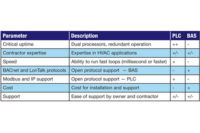Each month in this column, we talk about the benefits of control systems and BAS. It might lead the reader to believe that these systems are highly optimized and result in comfortable, efficient buildings. Unfortunately, nothing could be further from the truth. The vast majority of control systems are operating at less than optimal performance, providing less than optimal operation, and are not regularly used by the building operations team. While this sounds dire, it is not a difficult task to recommission or tune up an existing control system to improve efficiency. The following is a brief summary of some of the key issues we look at when evaluating existing systems.
User Interface
Generally, the first thing we do when evaluating an existing BAS is to sit down with the building engineer at the user interface and view the major building systems. Here are some key items to look for.
- Does the building engineer regularly use the system?
- Can they both view and make key changes?
- Does the system have a graphical user interface?
- Does it appear to represent what is installed?
- Is the system performance sluggish, or do data and graphics come up slowly?
- Are there any communications problems or info that doesn’t display?
- Finally, does the data appear to make sense (i.e. units are correct, results are within a reasonable range)?
Making sure that the system is readily accessible, that the data is correct, and that the operators understand how to use it are key items to improving the performance of any BAS.
Operating Values
We generally focus on a few key parameters for efficient operation.
- Schedules. Systems should be scheduled to match the building occupancy. There is no better strategy for reducing energy use than turning off a system that doesn’t need to be running!
- Free cooling. Is there an economizer? How is it set up? What is the change over logic? Is it working properly? Scheduling free cooling is a “no brainer” strategy that can readily reduce energy costs with no impact on comfort.
- Simultaneous heating and cooling. While some reheat in a system is hard to avoid, we look carefully to see if there are cases where we are heating and cooling the same airstream or room at the same time.
- Setpoints. Do the setpoints make sense? This applies to every system from air handlers and chiller plants down to the terminal units. For example, we look at the airflow settings on VAV terminals, the static pressure setpoints on air handlers, and chilled water setpoints on the chiller plant.
- Control. Do things appear to be in control? Are setpoints being achieved? This is valuable to view on a screen but even better to view on a trend so that we can see if it is working in a stable manner over time.
The operating values tell a lot about how a system was originally designed and installed, as well as about how it is operating today. We often find problems with one or more of the items listed above. Resolving these issues can be as simple as a basic tune up or recommissioning process, but more often than not, they may require some fairly significant engineering calculations as well as improved control sequences.
At the end of the day, regular inspection, updates, and education on the use of a BAS have the potential to significantly improve the efficiency of the facility and will generally pay off in terms of improved energy efficiency. The process can be achieved by a well-trained building technician, an energy and systems engineer, or through the use of tools such as continuous commissioning and analytics.




